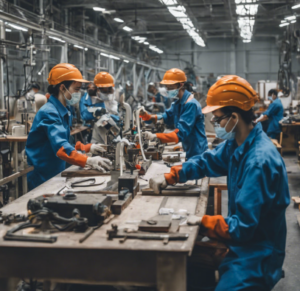
In early January 2025, the Caixin Purchasing Managers’ Index (PMI), a key economic indicator for China’s manufacturing sector, revealed a marked slowdown in factory activity. The report, which covers December 2024, showed a decline in the index to 50.5 from 51.5 in November. This suggests that while China’s manufacturing sector is still expanding, the pace of growth has considerably slowed.
For an economy as significant as China, such data is crucial in gauging not only the health of the country’s industrial sector but also its potential effects on the global economy. This slowdown is attributed to a combination of factors, including weaker demand, external trade risks, and ongoing structural challenges. In this article, we will explore the causes of this slowdown, its impact on China’s manufacturing industry, and its broader implications for global markets.
What is the Caixin PMI and Why Is It Important?
The Caixin PMI is a monthly economic index based on surveys of purchasing managers across the Chinese manufacturing sector. The index is compiled by Caixin Media in partnership with Markit Economics and is widely regarded as a critical tool for understanding trends within China’s industrial activity.
The PMI score ranges from 0 to 100, with readings above 50 indicating expansion and readings below 50 signifying contraction. The PMI is divided into several sub-indexes, including production, new orders, employment, and supplier delivery times, which provide further insight into the state of the economy.
In essence, the Caixin PMI offers a real-time snapshot of China’s manufacturing activity and serves as a vital indicator for economists, businesses, and policymakers. A drop in the index often signals a cooling economy, which, given China’s pivotal role in global trade, can have widespread implications.
The December 2024 PMI Results:
For December 2024, the Caixin PMI recorded a value of 50.5, which marks a slight contraction in growth compared to the 51.5 score in November. Although the PMI remains above the neutral level of 50, it reflects a significant deceleration in factory activity.
The details from the PMI report show that several components within the index have weakened:
-
New Export Orders: A critical sub-index measuring demand for Chinese exports has fallen for the fourth consecutive month. Weakening demand from international markets, including the U.S. and European Union, has dampened the growth of exports, which traditionally serve as a major driver for Chinese manufacturing.
-
Production: The production sub-index, which tracks output levels in the manufacturing sector, showed a slowdown. This decline suggests that factories are operating at lower capacity due to decreased demand, both domestically and internationally.
-
Employment: The employment sub-index showed minor improvement, indicating that while growth is slowing, companies remain cautiously optimistic about the future and are holding on to their workforce.
The overall tone of the report is one of caution. While expansion continues, it is evident that China’s manufacturing sector faces significant challenges moving forward.
Factors Behind the Slowdown
Several interconnected factors contribute to the deceleration of China’s factory activity. These can be broadly classified into three categories: external economic pressures, domestic economic policies, and structural changes within the manufacturing sector itself.
1. Weak External Demand
A significant factor behind the slowdown is the decline in external demand for Chinese products. Over recent months, many of China’s major export partners, particularly Western countries, have been experiencing slower economic growth. The United States, for example, has faced ongoing trade tensions with China, compounded by potential new tariffs and restrictions.
Many of China’s key manufacturing sectors, such as electronics, textiles, and machinery, rely heavily on demand from international markets. As the U.S. and European economies experience slowdowns, Chinese manufacturers are finding it increasingly difficult to secure new export orders. In addition, other regions, such as Southeast Asia and Latin America, have become more competitive, taking some market share away from Chinese manufacturers.
This external pressure has been particularly damaging to China’s smaller factories, which are less able to diversify and adapt to changing trade conditions.
2. Domestic Economic Challenges
Internally, the Chinese government has attempted to stimulate growth through various policies, including increased infrastructure investment and tax breaks for manufacturers. However, these measures have yet to translate into the desired uptick in manufacturing output. Domestic consumption in China has remained subdued, despite efforts to boost household spending and stimulate demand for goods and services.
The housing market, another critical component of the domestic economy, has also been underperforming. The real estate sector, which has traditionally been a key source of wealth creation in China, has faced cooling prices and reduced construction activity. This has further strained domestic demand for products produced by China’s manufacturing sector.
Additionally, China’s workforce is aging, and many manufacturers face rising labor costs as wages increase. This shift is exacerbated by a growing trend of automation, as companies seek to counter labor shortages and rising costs.
3. Trade Risks and Global Uncertainty
China’s manufacturing sector is highly sensitive to global trade tensions, particularly with the United States. For several years, trade relations between China and the U.S. have been marked by escalating tariffs and regulatory uncertainties, and the situation remains volatile.
The risk of new tariffs being imposed under U.S. trade policy, or the continuation of existing tariffs, creates a cloud of uncertainty for Chinese manufacturers. This uncertainty makes it difficult for businesses to plan for the future, which in turn affects production levels, investment decisions, and overall business sentiment.
In addition, broader geopolitical tensions—such as those between China and several Western nations—have contributed to global trade fragmentation. These geopolitical risks have discouraged foreign investment in China and have affected its ability to maintain strong trade relationships.
Implications for China’s Manufacturing Sector
China’s manufacturing sector is a crucial part of its economy, providing jobs for millions and contributing significantly to the country’s GDP. A slowdown in manufacturing activity is, therefore, a serious concern for policymakers.
Impact on Jobs and Employment
One of the immediate concerns resulting from slower factory activity is its impact on employment. While the employment sub-index showed some improvement in December, overall job creation remains a challenge. As factories cut back on production due to weaker demand, layoffs or reductions in hiring are likely to follow. This is especially troubling for China’s younger workforce, which faces increasing competition for jobs.
The government has already implemented a range of measures to support employment, such as subsidies for businesses that retain workers and programs designed to retrain those who lose their jobs in manufacturing. However, the broader issue of structural unemployment could continue to affect the sector, particularly in industries that are increasingly being automated.
Impact on Growth and Economic Rebalancing
China’s government has long been working toward rebalancing its economy by shifting from an investment-driven model to one that is more reliant on domestic consumption. However, this shift has proven difficult, and the manufacturing sector’s challenges reflect this broader transition.
The slowdown in factory activity signals that the road to economic rebalancing may be longer than anticipated. While China’s service sector has grown, the country remains heavily reliant on manufacturing for overall economic growth. As factory activity weakens, this could lead to slower-than-expected economic growth, especially as global economic conditions remain unstable.
The Government’s Response and Stimulus Measures
In response to the slowdown in manufacturing, the Chinese government has introduced a range of measures aimed at stimulating growth. These include tax cuts for small and medium-sized enterprises, increased infrastructure spending, and policies designed to boost consumption, such as subsidies for electric vehicles and consumer goods.
China’s government has also been investing in advanced technologies, such as artificial intelligence, robotics, and green energy, in an effort to modernize its manufacturing sector. These technologies are expected to improve productivity and reduce reliance on cheap labor, which has been a challenge for the country’s traditional manufacturing industries.
Global Implications of China’s Manufacturing Slowdown
China is not only the world’s largest manufacturer but also one of the largest exporters, and as such, the slowdown in its factory activity could have significant ramifications globally.
Countries and companies that rely on Chinese products or raw materials may face rising costs or supply chain disruptions. This is especially true in sectors like electronics, automotive manufacturing, and consumer goods, all of which depend on Chinese-made components.
Furthermore, the slowdown in China’s manufacturing activity could influence global inflation. As China slows production, the prices of Chinese goods may rise, contributing to inflationary pressures in other parts of the world. The ripple effects could be felt most acutely in regions with strong economic ties to China, such as Southeast Asia, Africa, and Europe.
The latest Caixin PMI data presents a clear picture of a slowdown in China’s manufacturing sector, reflecting a confluence of domestic and global challenges. While the Chinese government has taken steps to mitigate the impact of these challenges, the manufacturing sector’s struggles are a reminder of the complexities involved in transitioning to a more consumption-driven economy.
Looking ahead, the trajectory of China’s manufacturing sector will depend on the successful implementation of government stimulus measures, the resolution of trade disputes, and the ability of the economy to adapt to changing global conditions. For now, businesses and policymakers alike must navigate a period of uncertainty, one that holds significant implications for both China and the global economy.
Feel free to check out our other website at : https://synergypublish.com

